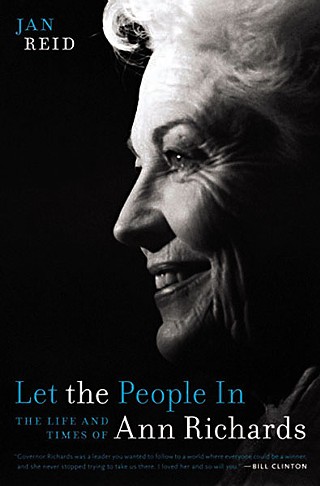Point Austin: Missing Ann Richards
New biography recalls the highwater mark of Texas liberalism
By Michael King, Fri., Oct. 19, 2012
Near the end of his fascinating new biography of the late Texas Gov. Ann Richards, Let the People In, author Jan Reid allows himself to speculate briefly whether it all might have turned out differently – that is, if the end of Richards' administration had concluded more like its celebratory beginning ... or more simply, if her 1994 gubernatorial re-election campaign had ended with a victory.
"There were so many what-ifs surrounding the Texas race in 1994," Reid writes. "What if Bush had gotten the job as the commissioner of Major League Baseball? What if he had listened to his doubts and decided not to run? What if Ann hadn't run? What if she had won?"
A biographer can't spend too much time wondering about alternative narratives – telling the story directly in front of him is quite enough – but Reid does insist that, despite broader political trends working badly against the incumbent Richards, "[t]he outcome was not preordained. Ann blew that election all on her own." That may be true; even after reading Reid's copious reconstruction of the twists and turns of that campaign, I'm not equipped to dispute his judgment.
What struck me more forcibly, nearly two decades later, is how quickly it all went away. Not simply that Richards' governorship flamed out – Reid calls that section "The Parabola" to invoke the meteoric ascent and equally abrupt descent of her time in office. But with her went the seemingly breathless moment on the political stage of Austin-centered liberalism, embodied not only in Richards (and the remarkable group of people around her, such as Reid; his wife, Richards' aide Dorothy Browne; and a host of others), but in Land Commissioner Garry Mauro and Ag Commissioner Jim Hightower, and (by somewhat strained extension) Attorney General Jim Mattox, and Lt. Gov. Bob Bullock.
In retrospect – after Richards was succeeded by George W. Bush, soon pointed toward the dynastic national stage – the historical moment seems ephemeral, a dream of a liberal ascendancy (by Texas standards, anyway) that abruptly disappeared in the harsh Republican light of day.
Picking Up the Pieces
What happened? Was it all just Dubya and Karl Rove?
My stretch to include Mattox and Bullock suggests some of the alternative tale, as the former's reckless ambition and the latter's megalomania were pretty much bound to blow up any attempt to build Democratic coalitions that would last beyond one election cycle. And the years don't match up so neatly, either. After the 1982 victories of the "Yarborough Democrats," for example, Hightower was gone by 1992 (replaced by turncoat Rick Perry, remember him?). Bullock outlasted them all, although only by turning his back, in policy and person, on that brief progressive wave, and finally kneeling to the Bush ascendancy.
The understandable temptation, of course, is to find biographical reasons for all that misdirection and infighting, and all these personalities are dramatic enough to paint an Elizabethan version of the outcome. Richards and Bullock together could be portrayed as mutually ambitious Texas royalty, akin in goals and even personality but bitterly unable to find any way to successfully collaborate. (That mostly should be laid at the feet of Bullock, who could scarcely bear to be outshone by anyone, let alone a woman.)
Beyond the Capitol, of course, the statewide demographic shifts had more to say about the matter than anything these outsize actors did – forcing the Republican Party, and its many Perry-like party switchers, to the hard right and, not coincidentally, the overwhelmingly white. The intervening years, especially after two cycles of ruthless GOP gerrymandering, have only served to exaggerate our social and political polarization, hardly confined to Texas. (Voters in the recent GOP primaries, nationwide, were estimated at 90% white.)
The Might Have Been
All this acknowledged, Gov. Richards' hour upon the state and national stage was a heady and inspiring one, stretching back to those 1982 triumphs, the 1988 Democratic National Convention keynote speech, and of course the unforgettable January 1991 march up Congress Avenue from what is now the Ann Richards Bridge. For a good while, Richards blew the doors off the Capitol, and in Reid's adopted phrase, "let the people in." That meant African-Americans and Hispanics, as well as many previously overlooked and excluded women. Whatever else has happened in the years since, it is not possible to run a Texas campaign or a public office without at least paying lip service (and hopefully better) to the idea that all the people have a right to take part in governance. (Mitt Romney's grudging "women in binders" defense marks both how far we've come and how far we've still got to travel.)
What else had Ann wrought? Reid has a good deal to report on the nature of political compromise, including the embrace of capital punishment over the dismay of many of her supporters (no would-be Texas governor could do otherwise), and more broadly, her necessary reform of the Texas prison system from its virtually medieval state – which inevitably resulted in the massive expansion of that system. Richards rode those contradictions like Pecos Bill rode the tornado – or perhaps more literally, like the Harley she learned to ride late in life.
Could it have turned out differently? Could Richards have figured out a way to capture lightning in a bottle a second time, overcome her own misgivings (and the myriad accumulating failings, duly traced by Reid, of her Democratic allies), defeated Shrub, and altered forever the course of Texas and U.S. history?
Probably not. But as Hemingway once wrote, in quite a different context: Isn't it pretty to think so?
For more from Jan Reid on Ann Richards, see the Books section next week. Follow on Twitter @PointAustin.
Got something to say on the subject? Send a letter to the editor.











